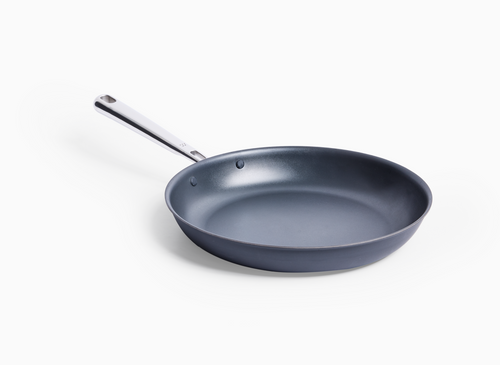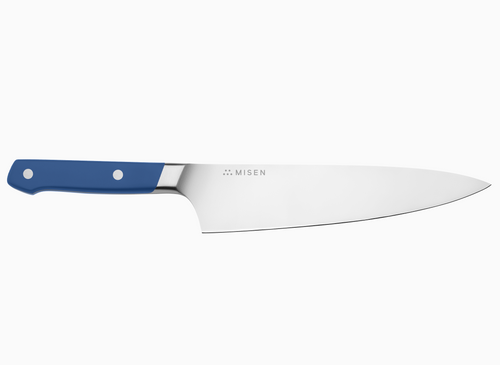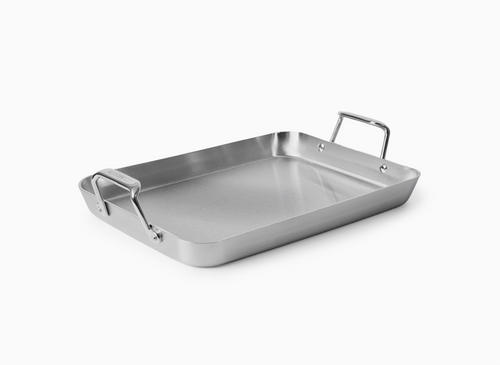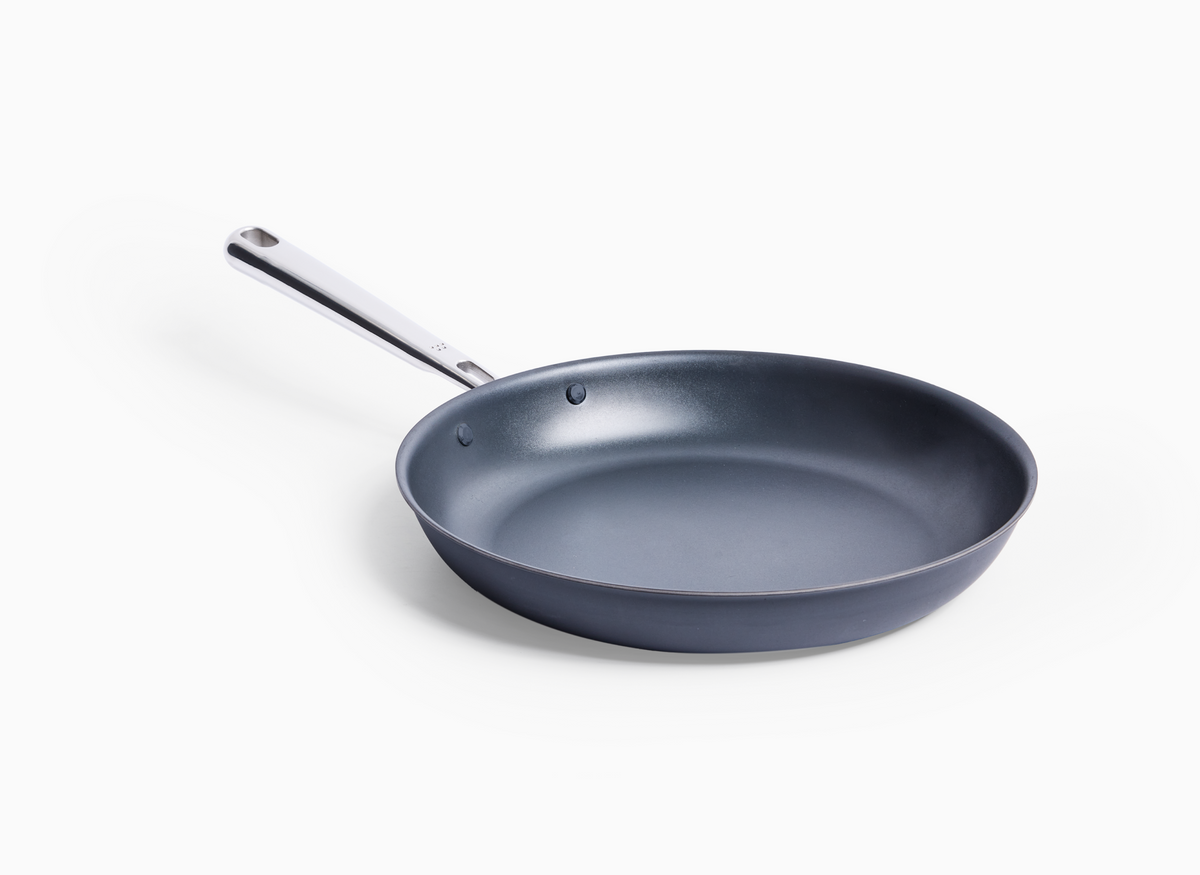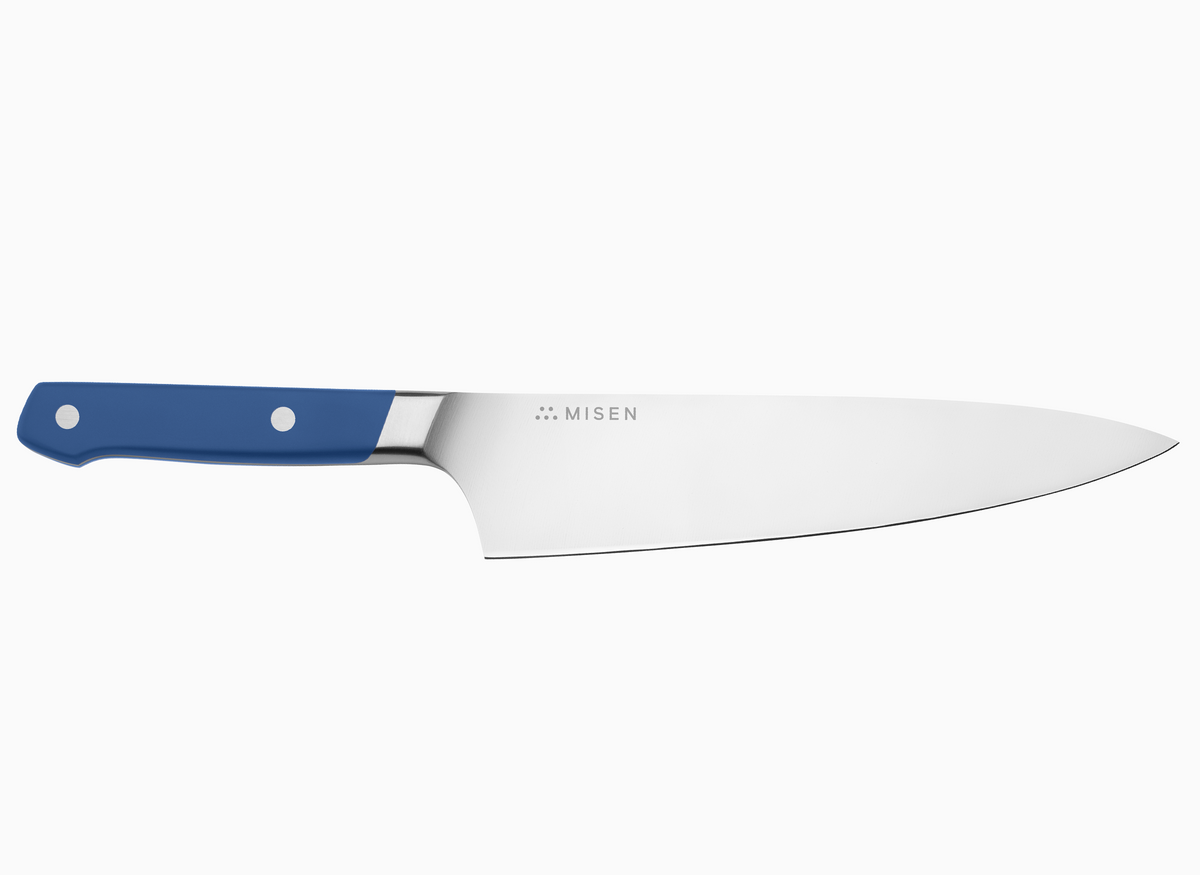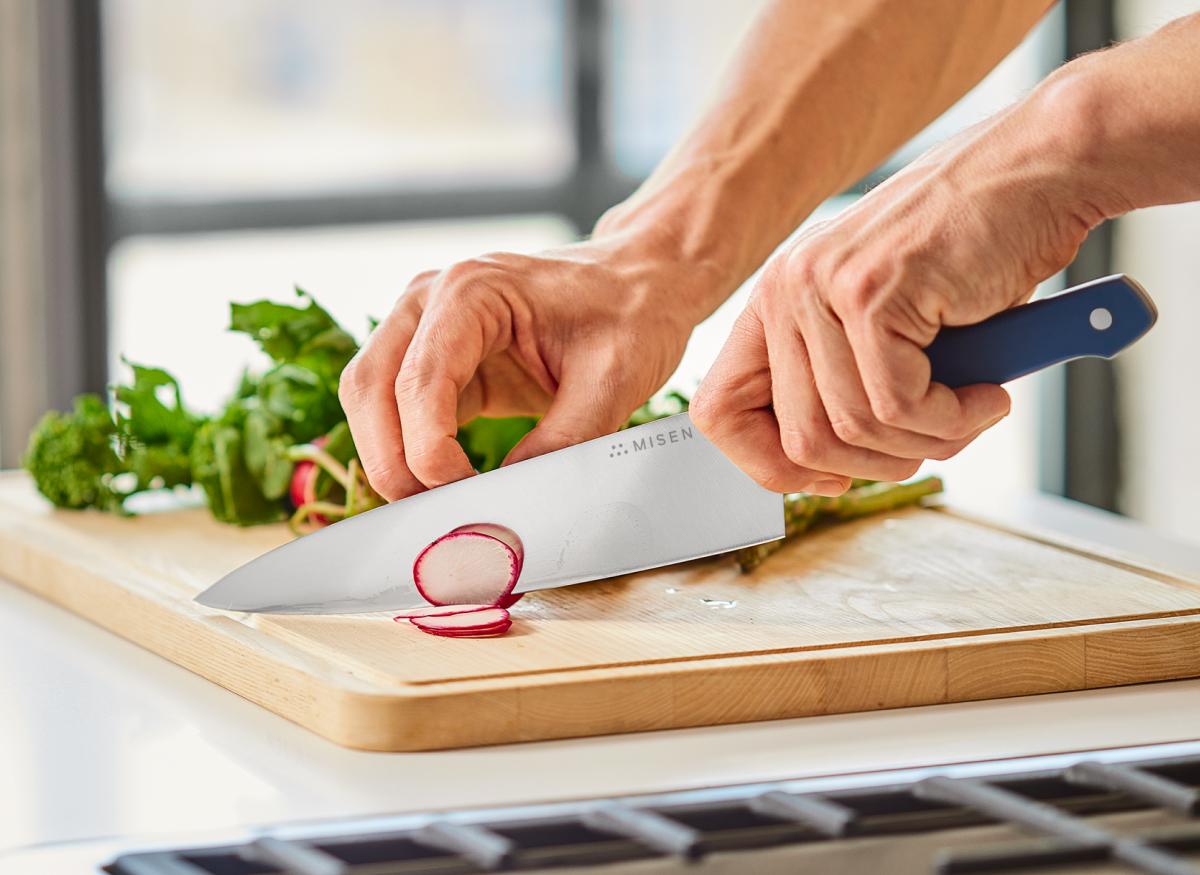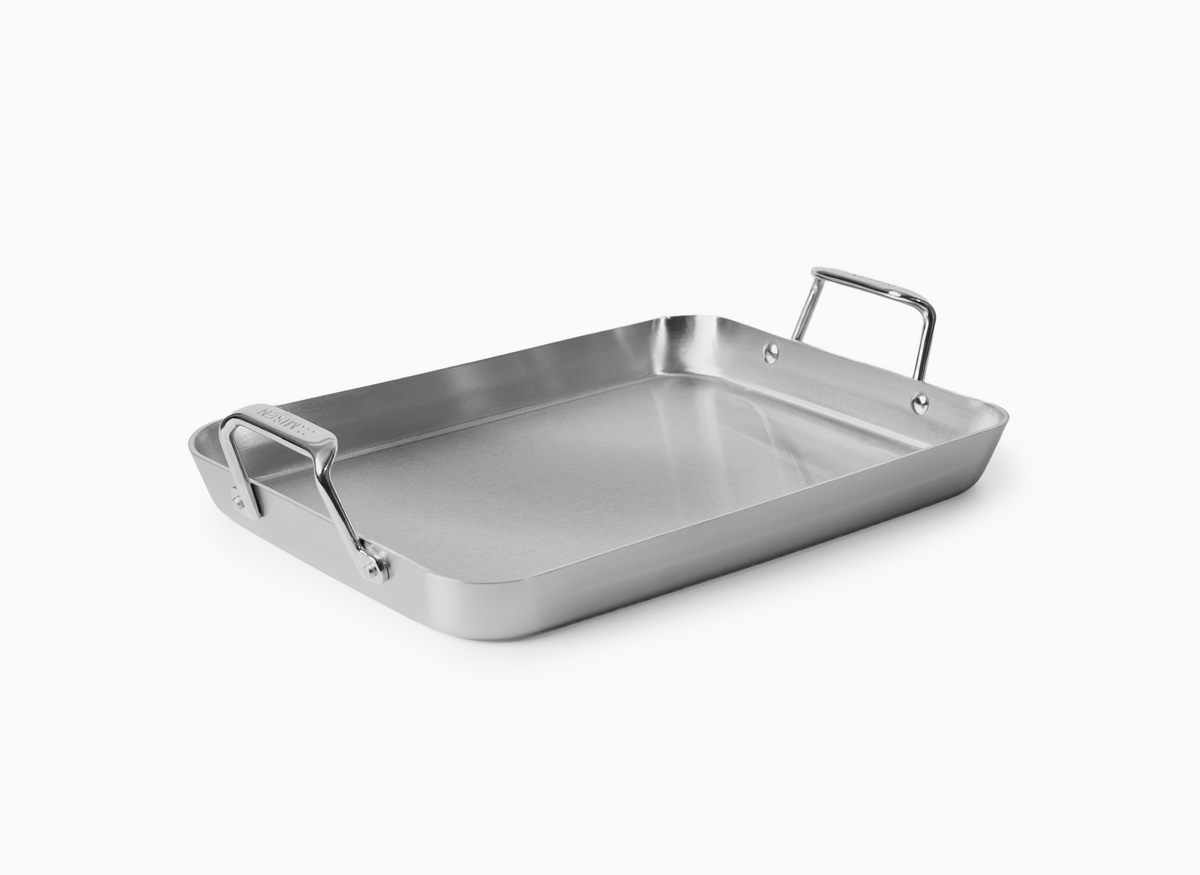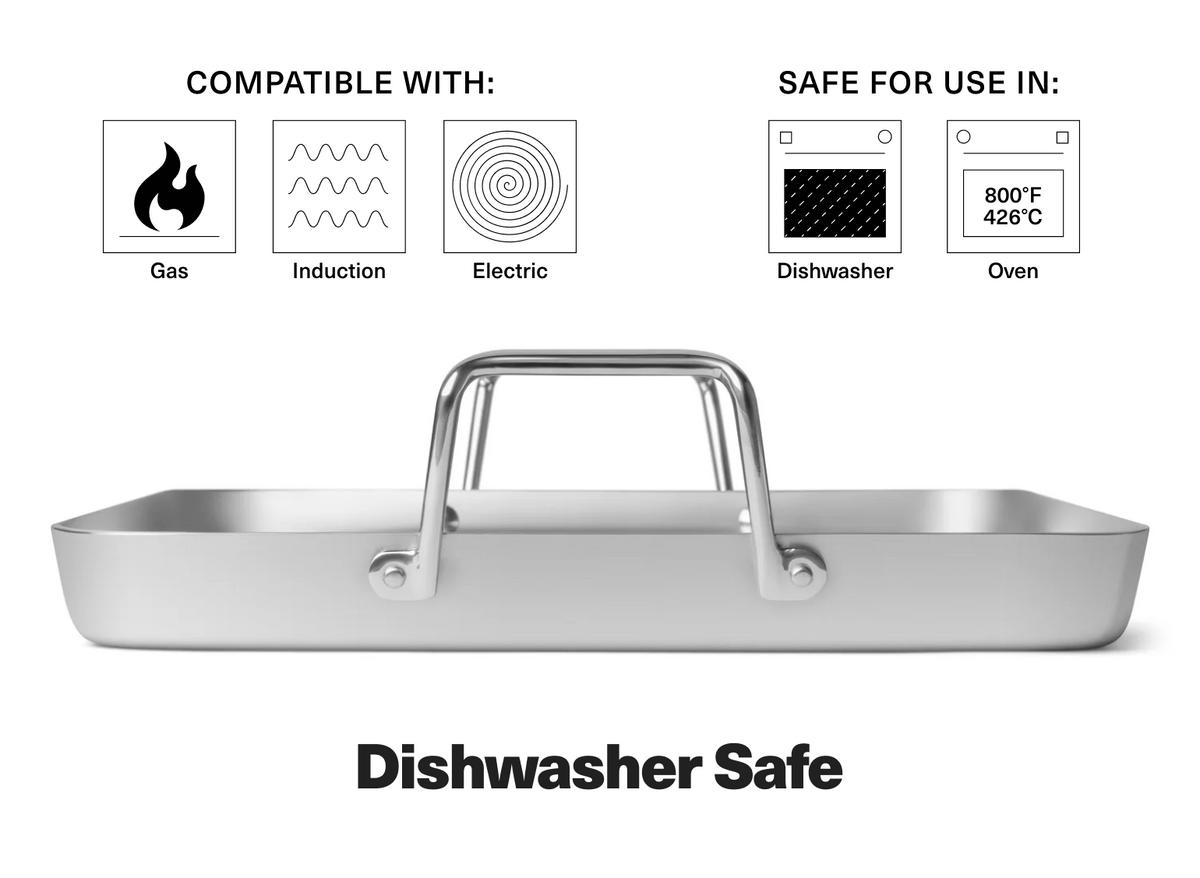Are Stainless Steel Pans Oven Safe?
Quality stainless steel pans are oven-safe powerhouses that can handle temperatures well beyond home-cooking needs when you understand their construction and limitations, making them indispensable for techniques like searing steaks on the stovetop then finishing in a 500°F oven. This comprehensive guide demystifies everything from decoding temperature ratings stamped on pan bottoms to understanding why tri-ply construction with aluminum cores prevents warping while ensuring even heat distribution across the cooking surface. You'll learn to navigate common misconceptions about plastic handles and thermal shock, discover why glass lids typically max out at 350-400°F even when your pan can go higher, and master practical skills like proper rack placement for optimal browning and using parchment versus foil for different cooking methods. Beyond basic oven safety, the article delivers professional insights on preventing discoloration through proper preheating techniques, restoring burnt pans with simple household ingredients like vinegar and baking soda, and making informed decisions about when to repair warped pans versus replacing them entirely. Whether you're debating between silicone-wrapped and all-metal handles, caring for high-heat discolored cookware, or determining if your non-stick stainless steel hybrid can handle oven temperatures, these evidence-based guidelines empower you to maximize your cookware's potential while avoiding costly mistakes that compromise both safety and performance.
Are Stainless Steel Pans Oven Safe? Key Facts
Quality tri-ply stainless-steel pans with chromium-nickel alloys can sail past 500°F in the oven, but always match the handle and lid ratings to keep the whole rig—and your dinner—safe.
What Makes Stainless Steel Oven‑Safe?
Here's what makes stainless steel such a reliable choice for oven cooking: it's all about the smart combination of metals. The chromium in stainless steel (typically 18%) creates a protective layer that shields against heat damage and rust [1][2]. This means your pan can handle extreme temperatures that far exceed what any home cooking requires [1].
The specific grade matters too. Food-grade 304 stainless steel—often labeled as 18/8 or 18/10—contains nickel alongside chromium, which boosts its heat resistance and durability [2]. This combination creates cookware that performs exceptionally well in high-heat situations [3].
What really sets quality stainless steel apart is tri-ply construction. Picture an aluminum core wrapped in stainless steel layers—this design gives you the best of both worlds: excellent heat distribution from the aluminum and superior durability from the stainless steel [2]. This smart engineering prevents hot spots and keeps your pan from warping, even when you're moving between stovetop and oven.
Common Misconceptions About Oven Use
Let's clear up some common myths about stainless steel in the oven. First up: "plastic handles mean no oven use. " Not true! Many modern handles use heat-resistant materials that can handle temperatures up to 300°F/150°C, with some premium options safe to 425°F/220°C [4]. Just check your specific pan's rating.
Another myth? "Stainless steel warps in the oven. " Quality pans hold their shape just fine with proper use—it's the shock of rapid temperature changes that causes problems, not steady oven heat [5]. Think of it like jumping into a cold pool versus easing in gradually. Here's something many home cooks don't realize: not all stainless steel pans are created equal when it comes to heat tolerance.
Construction quality makes a huge difference, with well-made tri-ply pans handling much higher temperatures than budget options. One last heads-up about lids: even if your pan can take 500°F heat, glass lids often tap out around 350-400°F. Always check both parts before cranking up the temperature—as we'll explore in detail in the next section about identifying safe components.
Why Quality Matters for Everyday Cooking
Here's why investing in quality stainless steel makes a real difference in your kitchen. Well-constructed pans with multi-ply layers give you consistent heat from edge to edge—no more burnt spots or uneven cooking when you transfer from stovetop to oven [6]. This even heating is what lets you nail techniques like searing a steak on the stove and finishing it perfectly in the oven. Professional kitchens rely on quality stainless steel because it delivers consistent results shift after shift.
The superior browning you get creates those complex flavors that make restaurant food taste so good [6]. Plus, while the upfront cost might seem steep, you're looking at cookware that lasts decades, not the few years you'd get from cheaper alternatives [6]. What should you look for? Fully-clad construction (metal layers throughout the entire pan, not just the base) and sturdy riveted handles that won't wobble after years of use [6].
Misen's [stainless steel pans](https://misen. com/products/stainless-steel-skillet) exemplify these features, combining professional-grade construction with home cook accessibility. When you understand what makes quality cookware, you can make choices that enhance your cooking for years to come.
How to Determine If Your Pan Is Oven‑Safe
Flip your pan, decode the oven-safe symbol or steel grade stamped underneath, match the handle material to its real temperature limit, and confirm with the manufacturer before sliding it past 350°F.
Reading Manufacturer Markings
Looking for those oven-safety markings on your pan? Start by flipping it over—most quality stainless steel cookware has clear indicators stamped on the underside or handles. You'll often find an oven symbol (looks like a square with a line through it) or straightforward text like "Oven safe to 500°F" [7]. Some pans show number codes instead—18/10 means your pan contains 18% chromium and 10% nickel, a combination that handles high heat beautifully without warping [7].
If you're comparing options, know that 300 series stainless steel (especially 304) delivers excellent oven performance, while 400 series offers solid heat resistance at a friendlier price point [7]. Can't find any markings? Don't worry—check your user manual or hop onto the manufacturer's website for specific temperature limits [8]. Quality makes a big difference here: budget-friendly pans usually max out around 350-400°F, while premium pieces like high-quality [stainless steel pans](https://misen.
com/products/stainless-steel-skillet) comfortably handle 500°F and beyond [7]. Just remember—even all-metal pans sometimes have hidden coatings or adhesives with lower heat limits, so always double-check with the manufacturer [8].
Identifying Safe Handle Materials
Let's talk handles—they're often what limits your pan's oven adventures. Solid stainless steel handles are your best bet for high-heat cooking, handling temperatures up to 500°F (260°C) like champs [9]. Yes, they'll get hot (keep those oven mitts handy! ), but they won't let you down when you need serious heat.
Got silicone-coated handles? They're great for comfortable stovetop cooking and can handle moderate oven temperatures—perfect for most everyday baking while staying cooler to the touch [10]. Phenolic handles step up from basic plastic options, typically safe up to 350°F (177°C), though pushing them beyond that might lead to cracking [10]. Here's a pro tip: look for handles attached with metal rivets rather than screws or adhesives.
These connection points tend to outlast the handle material itself [9]. And while ceramic handles stay cool longer, they can break if dropped—which is why you won't see them on most everyday cookware [10]. Whatever handle type you have, always check your specific pan's temperature rating since quality varies between brands.
Checking Lids and Accessories
Here's something many home cooks overlook—your pan might be oven-safe, but what about its lid and accessories? Glass lids are common but typically max out at 350-400°F, well below your stainless steel pan's capabilities. Push them too hard and you risk cracking—not the kind of kitchen surprise you want. Metal lids usually match your pan's temperature rating, but check those knobs!
Even metal lids sometimes have plastic or silicone knobs that can't handle high heat. Same goes for any removable parts—silicone grips, plastic handles, and rubber gaskets often tap out around 350°F or less. Planning to use steamer inserts or other accessories? Make sure they're the same quality stainless steel as your pan.
When in doubt, play it safe and stick to the lowest temperature rating among all your cookware components. Want the most flexibility? Look for cookware with all-metal construction from top to bottom—handles, knobs, and all [11].
Temperature Limits and Best Practices
Quality stainless steel pans thrive between 400-500°F, but only if you heat them gradually, avoid sudden temperature swings, and match every component—handles, lids, and coatings—to the oven's heat.
Typical Safe Temperature Ranges
Most stainless steel pans handle oven temperatures between 400°F and 800°F comfortably, with 500°F being the sweet spot for everyday cooking [12]. Here's what really matters: construction quality determines heat tolerance. Fully stainless steel pans—like quality tri-ply stainless collections—offer the best heat resistance, while non-stick coatings typically max out around 500°F before they start breaking down [12].
Your handle type makes a big difference too. All-metal handles can match your pan's maximum temperature rating, but silicone-wrapped handles and plastic components usually tap out at 350-400°F [12]. Don't forget about lids—tempered glass ones are generally safe only to 400°F, even if your pan can go higher [12].
Quality construction means better temperature tolerance across the board.
Gradual Heating and Cooling Tips
Think of your stainless steel pans like athletes—they perform best when properly warmed up. Start by placing your cookware in a cold oven and letting them heat together [13]. This gentle approach prevents the stress that comes from sudden temperature changes. On the stovetop, always begin with medium heat and work your way up if needed [14]. High heat on an empty pan?
That's a recipe for discoloration and warping—always have something in the pan first. After cooking, patience pays off. Let your pans cool down naturally before cleaning [14]. It's tempting to get dishes done quickly, but running hot cookware under cold water creates temperature shock that can permanently warp even quality pans [14]. Moving from stovetop to oven?
Keep the temperature transition smooth—your pan will thank you [13]. And when you pull that hot pan from the oven, set it on a trivet or cooling rack instead of directly on your cold countertop [13]. These simple habits keep your cookware performing like new for years to come.
Avoiding Thermal Shock
Thermal shock might sound dramatic, but it's simply what happens when your pan experiences a sudden temperature swing. Picture this: metal molecules expand when heated and contract when cooled. Hit them with an extreme change—like taking a hot pan and running it under cold water—and they can't adjust evenly, leading to warping [15]. While stainless steel handles temperature changes better than glass or ceramic, it's not invincible [15].
Here's how to keep your pans happy: skip the freezer-to-oven moves, set hot cookware on cooling racks instead of cold countertops, and let pans cool before washing [15]. Pro tip for deglazing? Use room temperature wine or broth rather than straight from the fridge [16]. Planning to sear on the stovetop then finish in the oven?
Start preheating while your pan warms on the burner—this creates a smooth temperature transition [1]. Small habits, big difference in your cookware's lifespan.
Using Stainless Steel Pans in the Oven – Practical Tips
Master the stovetop-to-oven move: sear steaks, chicken, or even shakshuka in your stainless pan, then slide it to the middle rack for even heat or the upper rack for a golden finish.
Best Recipes for Oven‑Finish Cooking
Stainless steel's stovetop-to-oven versatility opens up countless cooking possibilities. Start proteins like thick steaks or pork chops with a hard sear on the stovetop, then slide them into a 500°F oven for even cooking throughout [18]. This technique works brilliantly for chicken too—get that golden crust first, then let the oven finish the job for juicy, perfectly cooked meat [19].
One-pan pasta dishes shine with this method, building layers of flavor on the stovetop before the oven brings everything together [18]. For seafood, sear fish like snapper until golden in a [stainless steel pan](https://misen. com/products/stainless-steel-skillet), then finish in the oven to keep it moist and flaky [17].
Braised dishes and stews benefit from initial browning followed by slow oven cooking that develops deep, complex flavors [17]. Even egg dishes like Shakshuka work beautifully—sauté your vegetables and spices first, add eggs, then let the oven gently set them [17]. Match your pan to your recipe: wide sauté pans excel at searing proteins evenly, while deeper pans handle braises and saucy dishes better [17].
Positioning Pans for Even Heat
Where you place your pan matters. The middle rack delivers the most even heat—perfect for casseroles, baked pastas, and desserts that need consistent temperature throughout [22]. Want a golden-brown top? Move to the upper rack where heat concentrates near the broiler element, ideal for dishes with cheese or breadcrumb crusts [21].
The bottom rack provides intense bottom heat for pizzas, pies, and breads that need a crispy base [22]. Cooking multiple dishes? Stagger your pans instead of stacking them directly above each other—this ensures good airflow around each one [22]. Large roasts and whole chickens cook best on the bottom rack, positioned at the right distance from the heat source [21].
Convection ovens circulate air for more even temperatures, but rack position still affects browning [21]. In standard ovens, rotate your pans halfway through cooking to eliminate hot spots and ensure even results [20].
When to Use Parchment or Foil
When deciding between parchment paper and aluminum foil for your stainless steel pans, consider your cooking method and temperature. Use parchment paper for its natural non-stick properties when baking at temperatures up to 425-450°F—particularly for cookies, cakes, and delicate items that might stick to metal surfaces [23]. Parchment creates an easy-release surface without needing additional oils or sprays.
Switch to aluminum foil for high-heat cooking above 400°F, including broiling, roasting meats, or grilling [25]. Foil conducts and distributes heat effectively while conforming perfectly to your stainless pan's shape, making it ideal for protecting the surface from burnt-on bits and minimizing cleanup [23]. When cooking acidic foods like tomato-based sauces, avoid direct contact with aluminum foil as it can cause adverse reactions and discoloration in your food [25].
For sticky foods with high sugar content, parchment offers better performance than foil, which would require cooking spray to achieve similar non-stick results [23]. Remember that wax paper is never a suitable substitute for either material in the oven, as its coating melts at low temperatures [24].
Caring for Your Oven‑Safe Stainless Steel Pans
Cool the pan fully, then attack heat tint with a vinegar boil, deglaze burnt bits with hot water, and finish with Bar Keepers Friend to restore a mirror shine without warping your stainless steel.
Cleaning After High‑Heat Use
High-heat cooking often leaves stainless steel pans with stubborn discoloration and burnt-on residue. First, always let your pan cool completely before cleaning—as discussed in the temperature management section, sudden temperature changes can permanently warp your cookware [26]. For rainbow discoloration (heat tint) that appears after high-temperature cooking, white vinegar breaks down the oxidized layer effectively.
Either apply diluted vinegar directly or create a solution with one part vinegar to three parts water and bring it to a boil in the affected pan [27]. Burnt-on food responds best to a deglazing technique—add hot water to the cooled pan and use a long-handled dish brush to safely loosen food particles while keeping hands away from any remaining heat [26]. For particularly stubborn residue, Bar Keepers Friend outperforms other cleaners including baking soda, requiring less scrubbing while restoring pans to a gleaming finish [28].
For severely scorched pans, try the baking soda boil method: add water and about ¼ cup of baking soda, bring to a gentle boil, then let most liquid evaporate. The resulting slurry breaks down even the toughest burnt-on food [26]. After any deep cleaning, rinse thoroughly and dry immediately with an absorbent towel to prevent water spots that can lead to corrosion [27].
Preventing Warping and Discoloration
Managing heat exposure is key to preventing warping and discoloration. As covered in the thermal shock section, always let pans cool before cleaning [27]. Discoloration happens when pans overheat, especially when empty [27].
Use appropriate amounts of fat or liquid and move food frequently to maintain even heat distribution [27]. Ceramic stovetops concentrate heat intensely, so use extra care with temperature settings [29]. Quality construction matters—well-made stainless steel pans resist warping better than budget alternatives, though proper handling is essential regardless of price [29].
Stick to medium heat or lower unless your recipe specifically requires higher temperatures [29]. If slight warping occurs, you can sometimes fix it by carefully tapping the warped area from underneath with a rubber mallet [29]. Choose wooden or silicone utensils over metal to prevent scratches that can lead to staining [27].
Long‑Term Storage for Durability
Proper storage significantly extends the life of stainless steel cookware. Before storing, ensure pans are completely clean and dry to prevent discoloration and rust [30]. Stack with soft cloth or paper towels between each piece to prevent scratches [30].
Hanging pans on wall-mounted racks frees cabinet space and improves air circulation [30]. If stacking is necessary, use dividers to prevent pieces from touching [30]. Store pans in dry locations away from dishwashers, sinks, or damp basements where humidity accelerates corrosion [30].
For special pieces used less frequently, wrap loosely in acid-free paper for extra protection. These storage practices work with your cleaning routine to keep your cookware performing beautifully for years [31].
Frequently Asked Questions About Oven Use
Before sliding that pan into a 450 °F oven, flip it over—if it’s non-stick or has a silicone handle, you’ll need to swap to bare stainless or cast iron to keep the coating from degrading and the grip from melting.
Can I Use Non‑Stick Stainless Steel in the Oven?
Non-stick stainless steel pans have different oven safety considerations than standard stainless steel. While high-quality stainless steel can withstand temperatures up to 500°F or more, non-stick coatings significantly limit heat tolerance [7]. Most non-stick surfaces begin degrading at lower temperatures, with Teflon specifically starting to release toxic gases at 446°F according to DuPont studies [32].
Manufacturers typically rate their non-stick cookware between 350-400°F for oven use, substantially below the capability of uncoated stainless steel [32]. Always check your specific pan's rating—many quality non-stick pans display their maximum oven temperature on the underside or in product documentation [7]. When heat ratings aren't clearly labeled, default to the conservative maximum of 350°F for non-stick surfaces [32].
For recipes requiring higher temperatures, consider transferring food to conventional stainless steel or cast iron cookware before placing in the oven, as these materials offer superior heat resistance without the risk of coating degradation.
Are Silicone‑Wrapped Handles Safe?
Silicone-wrapped handles on stainless steel pans are generally oven-safe, but with significant temperature limitations compared to all-metal alternatives. Most silicone-wrapped handles tolerate temperatures between 375-400°F, substantially below the 500-600°F range of fully metal handles [12]. Manufacturer specifications vary considerably: GreenPan rates their silicone-insert handles safe to 375°F, while T-fal pans with silicone-wrapped handles can withstand up to 400°F [33].
These temperature restrictions create practical limitations for high-heat cooking techniques like broiling or searing-then-roasting at temperatures above 400°F. The primary advantage of silicone-wrapped handles—comfortable grip during stovetop cooking—becomes their limiting factor in oven applications. For maximum versatility, consider pans with solid stainless steel handles that can withstand temperatures up to 600°F without damage [33].
If your existing cookware has silicone handles, verify the exact temperature rating from the manufacturer rather than guessing, as exceeding these limits can cause handle degradation, warping, or the release of potentially harmful fumes [12]. Always use potholders regardless of handle material, as even silicone-wrapped handles become dangerously hot during oven use despite their heat-resistant properties [12].
What to Do If a Pan Gets Damaged?
Assess your damaged stainless steel pan before deciding whether to repair or replace it. For warped pans that no longer sit flat, try placing the pan on a strong, flat surface and gently tapping it in a circular pattern with a rubber mallet to flatten the base [34]. Don't hit too hard—use moderate force and check progress periodically with a straight edge.
For minor warping, some home cooks successfully create a slight inward indent by positioning the pan over wooden supports and carefully striking the center [34]. However, extensive warping often signals it's time for replacement, as fixed pans frequently re-warp when heated again [34]. For scratched surfaces, continue using the pan normally—superficial scratches don't affect cooking performance or food safety.
Discoloration from high heat responds well to vinegar solutions or baking soda pastes as detailed in the cleaning section. For severe damage like cracks or deep dents, replacement is typically more economical than repair, as professional welding services for stainless steel often exceed the cost of new cookware [34]. Quality stainless steel pans maintain their performance despite minor cosmetic issues, making complete restoration unnecessary unless the damage affects cooking function.
- Quality tri-ply 304 stainless steel pans safely reach 500°F in ovens.
- Check handle material: silicone wraps max out at 375-400°F, all-metal to 500°F+
- Glass lids usually limited to 350-400°F even if the pan tolerates higher heat.
- Avoid thermal shock: let pans cool before washing or placing on cold surfaces.
- Non-stick coated stainless pans cap at 350°F to prevent toxic fume release.
- Fully-clad, riveted construction resists warping and ensures even oven heating.
- Deglaze stubborn residue with hot water; vinegar removes rainbow heat tint.
- https://gengfeisteel.com/news/can-you-put-stainless-steel-in-the-oven/
- https://mightynest.com/articles/stainless-steel-all-about-food-grade-304-188-and-1810?srsltid=AfmBOopZru7aIyPpCZ6B5HhMgFoOP2xNq6aYLMmK2GmnhqVIWdpPlvXc
- https://www.marlinwire.com/blog/food-grade-stainless-steel-facts
- https://blog.fbm.eu/can-cookware-go-in-the-oven-debunking-a-common-cookware-myth
- https://circulon.uk.com/blogs/the-culinary-circle/common-stainless-steel-cookware-myths-busted
- https://www.reviewed.com/cooking/features/how-to-cook-with-stainless-steel-cookware
- https://www.thekitchn.com/stainless-steel-in-oven-23705483
- https://smart.dhgate.com/how-to-confidently-identify-oven-safe-pans-and-avoid-kitchen-mishaps/
- https://www.solamexhome.com/how-to-choose-an-oven-safe-frying-pan-materials-temp-ratings-and-dos-donts.html
- https://www.xianghai.com/news/comparing-the-top-heat-resistant-knob-materials-for-cookware/
- https://www.boroughkitchen.com/blogs/news/a-guide-to-stainless-steel-pots-pans
- https://prudentreviews.com/stainless-steel-cookware-oven-safe/
- https://www.tataneu.com/pages/electronics/home-appliances/how-to-safely-use-steel-cookware-in-your-oven
- https://misen.com/blogs/news/how-to-use-stainless-steel-pans-for-beginners?srsltid=AfmBOooxPLzdozjgvDu7nL8BrnqXAn-rS0YWmxhReBke5gCQ_WmnaipW
- https://www.skottsberg.com/en/knowledge-center/information/thermal-shock/
- https://www.debuyer-usa.com/blogs/guides/what-to-know-about-stainless-steel-cookware?srsltid=AfmBOorpSivKj40ZxC0CbeKhbxtBrKXjZ1fiwW54fnfnXrtZc_tbdJld
- https://www.lecreuset.ca/en_CA/blog/8-recipes-for-every-piece-of-ss-cookware.html?srsltid=AfmBOopSdFfkUDd6LXwZWB5u9qR9V7PE26i69vBuhMMyYvK6bCcaLy3Y
- https://www.tasteofhome.com/article/how-to-cook-with-stainless-steel/
- https://mintykitchen.com/how-to-cook-with-stainless-steel/
- https://misen.com/blogs/news/how-to-cook-with-stainless-steel-1?srsltid=AfmBOopQ-MVzglX4Tl8TrY4BFsk4l2LIX4IKM1dgv39jvamMbl5qCPAi
- https://www.maytag.com/blog/kitchen/oven-rack-placement-for-baking-broiling.html
- https://www.whirlpool.com/blog/kitchen/oven-rack-placement.html
- https://www.tasteofhome.com/article/parchment-paper-vs-aluminum-foil/
- https://www.realsimple.com/food-recipes/cooking-tips-techniques/parchment-paper-vs-wax-paper-vs-foil
- https://www.southernliving.com/food/kitchen-assistant/parchment-paper-wax-paper-or-aluminum-foil?srsltid=AfmBOooMix1rhKY5x20HQtA66pUAPb60NANu8hHTOwkTdDuRdebASosg
- https://www.nytimes.com/wirecutter/guides/how-to-clean-stainless-steel-pans/
- https://www.marthastewart.com/7617742/how-care-stainless-steel-pan-prevent-burning-warping
- https://misen.com/blogs/news/how-to-clean-stainless-steel-pans-ultimate-step-by-step-guide?srsltid=AfmBOorZDkBxtSc22nwG5tGTGcZJCagTdBVR2N2VbBFizeNUgofjGp2M
- https://www.reddit.com/r/Cooking/comments/16v66fu/is_it_normal_for_stainless_steel_pans_to_warp_a/
- https://aviasworld.com/blogs/general/store-stainless-steel-cookware-properly-to-prevent-damage?srsltid=AfmBOorI4lOe5LYfFlvd0sz402OZHe0mt1s9mUgClO3dHf5Tpq2_2n-U
- https://food52.com/story/15027-our-guide-for-caring-for-cleaning-stainless-steel-pans
- https://cooking.stackexchange.com/questions/4972/can-nonstick-pans-go-in-the-oven
- https://www.solamexhome.com/how-do-i-know-if-my-pan-is-oven-safe-a-definitive-guide-to-material-checks-label-clues-and-safe-testing.html
- https://www.quora.com/How-can-I-fix-a-stainless-steel-pan-that-has-bowed-out-in-the-center-and-no-longer-sits-flat
